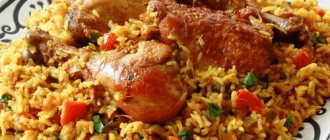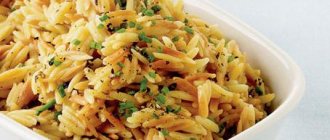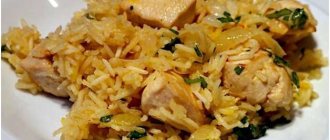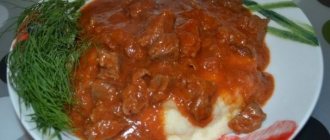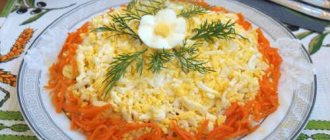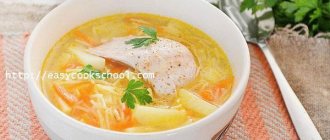Rice of the right varieties
Experienced chefs will immediately tell you what the main secret of pilaf is. This is the right rice. The main requirement is that the grains must be quite dense and hard, with a minimum starch content. Only then will they not boil over during simmering and retain their perfect crumbliness. Experienced craftsmen advise giving preference to Uzbek and Tajik varieties, such as devzira, alanga, oshpar, barakat, akmarzhan. Any brown rice varieties that retain the bran shell are also allowed. But you shouldn’t replace them with steamed varieties. Instead of crumbly rice, you will get viscous rice porridge with meat. Before cooking, rice should be rinsed in water 6-8 times. This will help get rid of starch dust and prevent the grains from sticking together in the cauldron. Some housewives soak the washed grains in cold water for half an hour.
Pilaf with meat and raisins
Ingredients:- Rice - 300 grams
- Beef - 500 grams
- Raisins – 100 grams
- Carrots - 1 piece
- Onion - 1 piece
- Salt - to taste
- Garlic - 1 head
- Vegetable oil - 4 tbsp.
- Black pepper - to taste
Detailed description of the recipe with step-by-step photos
Perfect meat
The next important ingredient for pilaf is meat. In classic Central Asian pilaf it is lamb and only lamb. Moreover, it should be the meat of an adult animal, preferably shoulder, brisket or back. Only it gives the pilaf a unique juiciness and intense taste. In Muslim countries, for obvious reasons, pork is not used. But in Asian countries this option is quite acceptable. Beef, chicken, turkey and even fish are also added to pilaf. It is better not to take veal. From long simmering it becomes tough and does not give a rich aroma and taste. In any case, the meat should be fresh or chilled, but in no case frozen. Cut it into cubes no smaller than 5 × 5 cm. In some recipes, the meat is fried in large pieces and chopped before serving.
Vegetarian pilaf with bulgur
Ingredients:- Rice - 1/2 cup
- Bulgur - 1/2 cup
- Carrots - 1 piece
- Dried apricots - 6-8 pieces
- Orange - 1 piece
- Salt - to taste
- Pomegranate - 1/2 piece
- Lemon - 1/2 piece
- Pear - 1 piece
- Onion - 1 piece
Detailed description of the recipe with step-by-step photos
Vegetable set
The two main vegetables in pilaf are onions and carrots. Almost all recipes use onions. Sometimes you can find red onions, which give a more expressive piquant taste. The onion is cut into fairly large half rings. If you chop it too much, the onion will quickly overcook. In Central Asian countries, yellow carrots are added to pilaf. However, the more common orange varieties will not affect the taste much. The root vegetable is cut into thick, long strips. It’s not worth chopping carrots, even on the coarsest grater. In this form, it will quickly burn, and this will definitely ruin the taste of the pilaf. What else can you add to pilaf? Raisins, dried apricots, dates and other dried fruits are used in Azerbaijani pilaf. They are first steamed in boiling water, dried and placed whole in pilaf.
Tajik
This is a recipe for crumbly delicious pilaf, which is passed down from generation to generation of the people of Tajikistan. It takes about 2 hours to prepare depending on the meat that will be used. To prepare pilaf, it is best to use Samarkand rice, which will make the dish a real delicacy. It is recommended to use lamb, pork and even turkey as additives - whoever likes what you like best. K/B/F/U - <200/<10/5-15/<20. Now let’s talk about how to quickly cook pilaf in more detail. For 7-8 servings you need to take:
- A kilogram of rice;
- 1 onion;
- 0.7 kg of meat (pork or lamb);
- 2 kilograms of carrots;
- 300 g butter;
- Seasonings (cumin, barberry and salt) to taste.
The cooking itself is extremely simple. But you must strictly follow the recipe.
Step 1. Rice is filled with salted water. It should sit for at least 20 minutes.
Step 2. Cut the onion into half rings, carrots into strips about 3 cm long. Don't let the number of carrots bother you. It gives the pilaf a unique piquant taste.
Step 3. The meat is separated from the bones and cut into large pieces.
Step 4. Heat up the cauldron and add all the oil.
Advice! To ensure that the pilaf is not greasy, but satisfying, add bones to the cauldron along with butter. Fry them until brownish and remove.
Step 5. Throw the onion into the oil. It is fried until golden brown.
Step 6. Add meat and salt with half of the selected amount. It begins to release juice. Therefore, it is necessary to reduce the heat and stir. When the juices have evaporated and the meat is fried until brownish, proceed to the next step.
Step 7. Add 2 kg of carrots, cumin and barberries if desired. Fry for 15-20 minutes. You need to stir gently. Gas is reduced to a minimum.
Step 8. Rice is placed in a cauldron, leveled and poured with boiling water. There should be about 2 fingers more water than cereal. Everything should simmer for 15-20 minutes.
Step 9. When the rice absorbs water, it needs to be stirred into the base. At this stage, the gas is turned off completely.
Step 10. Cover everything with a lid and leave for half an hour.
Oil and a bouquet of spices
From time immemorial in Central Asia, pilaf was cooked in fat tail fat. Modern recipes increasingly feature cottonseed or sesame oil. At home, you can be content with refined sunflower oil. Another important point is what spices are added to the pilaf. The classic set includes cumin grains, dried barberries, freshly ground black or red pepper. Several small hot peppers are buried in the swollen grains of rice. Garlic is placed in cloves or whole heads directly with the husk. What can I replace this set with? In the Caucasus, pilaf is seasoned with suneli hops, in India - with saffron, in Mediterranean countries - with thyme and coriander. By and large, there are no strict canons regarding seasonings for pilaf. You can safely improvise, choosing combinations that interest you.
Recipe for pilaf with mushrooms
Ingredients:- Mushrooms - 300 grams
- Carrots - 1 piece
- Pearl barley - 200 grams
- Vegetable oil - 2 tbsp.
- Onion - 1 piece
- Black pepper - to taste
- Salt - to taste
Detailed description of the recipe with step-by-step photos
Pilaf is a very ancient dish, and the ability to accurately prove its origin is questioned. In its meaning, “pilaf” goes back to the Sanskrit word, which meant “boiled rice.” Which does not contradict the use of other cereals. Pilaf is prepared by adding meat and fish to rice. This dish is found in many traditional cuisines of the world - Indian, Afghan, Turkish, Uzbek, Kyrgyz, Turkmen and many others.
In France, pilaf has turned into “miroton”, the analogue of pilaf in Italy will, of course, be risotto, in Spain - paella, and in India you will be treated to “biryani”.
Bon appetit!
Exact proportions
The proportions of ingredients play an important role in preparing pilaf. It's pretty easy to remember them. Rice, meat and carrots are taken in approximately equal proportions. Onions for such a quantity of products require at least 2-3 heads. You shouldn't skimp on oil either. For 1 kg of rice you need at least 250 ml of vegetable oil. The amount of water or broth depends on the container you are cooking in. The liquid should cover the ingredients by 1-2 cm. To be on the safe side, first pour in a little water and wait until it is absorbed. It is better to add a little more than to evaporate excess moisture for a long time. Spices are introduced based on personal taste preferences. If you don’t mind adding some sparkle to your pilaf, add more garlic, hot pepper and hot seasonings.
Chicken pilaf recipe
Ingredients:- Chicken – 800 grams
- Rice - 400 grams
- Broth or water - 400 grams
- Carrots - 250 grams
- Onions - 250 grams
- Garlic - 1 head
- Vegetable oil - 100 grams
- Zira - 1-1.5 tsp.
Detailed description of the recipe with step-by-step photos
It's all in the cauldron
The choice of utensils for pilaf should also be approached carefully. Experts experienced in this matter firmly stand on their own - real pilaf can only be cooked in a cauldron. It is best if it is cast iron or copper, in extreme cases - aluminum. An acceptable alternative to a cauldron can only be a duckling. Thanks to the thick walls and heavy bottom, the rice simmers at the right temperature without burning or sticking together. For all their advantages, deep frying pans with a non-stick coating or woks do not allow you to fully reveal the full bouquet of aromas and tastes of pilaf. The same can be said about the slow cooker.
Classic recipe for oriental pilaf
Required Products:
• Rice – 950 g. • Meat (lamb or pork is best) – 900 g. • Onions – 550 g. • Carrots – 700 g. • Oil, best sunflower, olive or cottonseed (can be replaced with fat tail fat) – 400 ml. • Garlic – about 2-3 large heads. • Spices and herbs depending on your taste.
The first stage of preparing pilaf is preparing all the products. The carrots need to be cut into thin strips or cubes, the onion into half rings. The meat is cut into small pieces, about 3.5 cm in size.
Rice must be thoroughly washed in cold water several times, then pour boiled water over it and leave aside for 1.5-2.5 hours. Next, you can begin the actual process of preparing pilaf. Of course, it is best to cook pilaf in a cauldron, but in a modern city this is hardly feasible.
A frying pan will be an excellent replacement for a cauldron - pour a small amount of vegetable oil into a hot frying pan and add pre-chopped meat. Let it brown for 6-8 minutes and remove, and add the chopped onion to the pan. As soon as the onion acquires a golden brown crust, you need to add carrots and pre-fried meat to it. At this stage, pepper and other spices, as well as herbs, are added to the dish. Garlic heads should be placed whole, without separating into cloves.
As soon as all the ingredients are ready, you need to pour a little clean water into the frying pan so that all the ingredients are covered by about 2.5 cm. Next, rice, previously steamed in hot water, is added to the pilaf. The rice is additionally filled with 2 fingers of water and placed on high heat for 5-6 minutes.
The vessel is tightly closed with a lid and placed on low heat for another 10-15 minutes. Then the dish is removed from the heat, but the lid is not opened, giving the dish the opportunity to brew and soak in the juices. After about 16-17 minutes, the lid can be removed and the pilaf can be scattered onto plates.
If desired, during the cooking process you can add a few tablespoons of barberry to the pilaf - thanks to this, the dish will acquire a unique oriental aroma.
Classic pilaf with lamb
Now that we have found out what is needed for pilaf, we suggest preparing this dish according to the classic Uzbek recipe. Choose moderately fatty lamb, taking into account the fact that here we will use fat tail.
Ingredients:
- lamb pulp - 1 kg
- fat tail fat - 300 g
- carrots - 1 kg
- Devzira rice – 1 kg
- onions - 2 large heads
- garlic - 3 heads
- hot red pepper - 2 pods
- coarse salt - 1 tbsp. l.
- cumin grains - 1 tsp.
- barberry berries - 1 tsp.
- additional spices - optional
Cut the fat tail fat into pieces approximately 1.5 × 1.5 cm. Cut the lamb coarsely into 5 × 5 cm cubes. Cut the onion into thick half rings. First cut the carrots into thick slices and then into long strips.
Heat a 5-6 liter cast iron cauldron over medium heat. We put in the tail fat, melt it, and catch the greaves with a slotted spoon. Increase the flame to maximum and add the prepared meat. Fry it quickly, stirring with a wooden spatula. It is necessary that the pieces are covered with a thin crust on all sides, but not dry out.
Reduce heat to medium, add onion, fry with meat until translucent, stirring occasionally. Now add the carrots, distribute them evenly and fry until they become soft. Add hot water until it slightly covers the carrots.
Mash the cumin grains a little with a pestle for a brighter aroma. Add cumin, barberries, whole hot peppers, heads of garlic and salt to the cauldron. Mix everything carefully - we have a zirvak. Place the pre-washed rice in an even layer on top of the zirvak and immediately fill one or two fingers with water. When the liquid boils, reduce the flame to a minimum, cover the cauldron with a lid and simmer for half an hour. Then, very carefully, using a wooden spatula, move the rice from the walls to the center. Otherwise, the lower layers will be overcooked and the upper layers will dry out. At the same time, we do not disturb Zirvak. Cover the cauldron with a lid and simmer for about another half hour. If the rice is completely cooked, but there is still liquid at the bottom, use a wooden stick to make several deep holes all the way to the bottom. Let the finished pilaf brew in a cauldron without fire for another 15–20 minutes.
Delicious and proven pork pilaf
Ingredients:- Pork – 1 kg (neck)
- Rice – 1 kg
- Onions – 1 kg
- Carrots – 1 kg
- Vegetable oil - 1 cup
- Garlic - 1 head
- Seasoning - to taste (for pilaf)
- Salt - to taste
